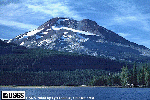 [Image,56K,JPG]
[Image,56K,JPG]
Aerial view, Three Sisters Volcanoes, Oregon, showing (left to right) South Sister, Middle Sister, and North Sister.
-- USGS Photo by Lyn Topinka, September 1985

| The Three Sisters |
 [Image,56K,JPG]
[Image,56K,JPG]
| "Faith", "Hope", and "Charity" |
| Volcanic Background |
| Volcano and Hydrologic Monitoring |
 Three Sisters Monitoring Menu
Three Sisters Monitoring Menu
| South Sister - Eruptive History |
 [Image,47K,JPG]
[Image,47K,JPG]
The geologic record shows that even much larger eruptions with much wider impact have occurred in the Three Sisters volcanic center. At least four times in the past 700,000 years, explosive eruptions that were probably sited near the present location of Broken Top and Three Sisters produced pyroclastic flows that swept over a broad area from Sisters to south of Bend. A tephra fallout deposit as thick as 13 meters (42 feet) composed largely of fist-sized and smaller white pumice clasts from one of these eruptions is exposed in numerous pumice quarries. Distal tephra deposits from this event have even been found in northern California and in cores from the northeast Pacific Ocean. Such an event today would be catastrophic for Deschutes County, but, fortunately, events of this magnitude are infrequent. Furthermore, there is no evidence that the large volume of magma necessary to drive such an eruption is present in the Three Sisters region today, nor would such a volume likely be generated in the near future.
| Glaciers and Glaciations |
| (The Neoglacial period was defined by Porter and Denton (1976) as encompassing the last 5,000 to 6,000 carbon-14 years, when alpine glaciers reformed and advanced. The "Little Ice Age" (Matthes, 1939) is generally regarded as the culmination of the Neoglacial period, and is a term used by climatologists, geologists, and glaciologists to describe a period of worldwide lower temperatures and advanced glacier positions from the 16th century through the late 19th century (Grove, 1988, p.3-5).) |
| Carver Glacier |
| Clark Glacier |
| Collier Glacier |
| Diller Glacier |
| Eugene Glacier |
| Hayden Glacier |
| Irving Glacier |
| Lewis Glacier |
| Linn Glacier |
| Lost Creek Glacier |
| Prouty Glacier |
| Renfrew Glacier |
| Skinner Glacier |
| Thayer Glacier |
| Villard Glacier |
Return to:
[Three Sisters Volcano Menu] ...
[Oregon Volcanoes and Volcanics Menu] ...
